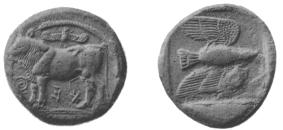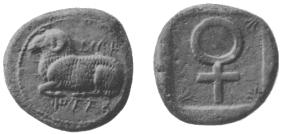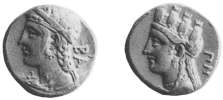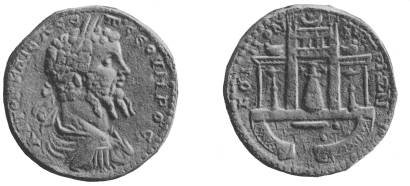
FIG. 325.



In the time of the Assyrian kings there were in the island of Cyprus ten small states, whose rulers are mentioned in several inscriptions. Three centuries later Diodorus (xvi. 42) enumerates nine kingdoms in the island—(1) Salamis, (2) Citium with Idalium and Tamassus, (3) Marium, (4) Amathus, (5) Curium, (6) Paphos, (7) Soli, (8) Lapethus, and (9) Ceryneia.
Notwithstanding the researches of Sir R. H. Lang (Num. Chron., 1871) and of others mentioned above, as well as of W. Deecke (in H. Collitz, Samml. d. gr. Dialektinschriften I, Die griechisch-kyprisehen Inschriften in epichorischer Schrift, 1883) and O. Hoffmann (Die griechischen Dia- lekte I, 1891), the attribution of a large number of Cypriote coins still remains a matter of considerable uncertainty. For tables of the Cypriote characters see the two last-mentioned works and Hill, pp. cxxxvi f.
The autonomous coinage of Cyprus begins in the latter part of the sixth century, and lasts till the subjection of the island by Ptolemy Soter, B.C. 312. It may be divided into the following principal classes:— (α) the money of the kings of Salamis, Idalium, Paphos, Marium, Soli, Amathus, and perhaps of other towns bearing inscriptions in the Cypriote and later in the Greek character; (β) the money of the Phoenician kings of Citium and perhaps of Lapethus, bearing Phoenician inscriptions. The weight-standard of all the silver money is at first the Aeginetic considerably reduced, so as almost to conform to the Persic. The stater, weighing about 179 grs. maximum, is not, however, divided into halves and quarters as in European Greece, but into thirds, sixths, twelfths, twenty-fourths, and forty-eighths, the denominations weighing 60, 30, 15, 7.5, and 3.7 grs. respectively. In the first half of the fourth century this system was modified (except at Paphos, where it was maintained to the last) and brought into harmony with the Rhodian standard, which began to prevail in south-western Asia Minor after B.C. 400. The later
In fabric the earliest coins (those attributed to Euelthon of Salamis) have a plain smooth reverse, which, about the time of the Persian wars, gives place to a well-marked incuse square containing a type. After about B.C. 400 the incuse square gradually disappears, except on the Phoenician coins of Citium, where it lingers on down to the age of Alexander. A frequent symbol on the early coinage is the ankh or crux ansata.
The following are the principal varieties of Cyprian money; details will be found in the introduction to the British Museum Catalogue.
Amathus. To this town is conjecturally attributed a series of coins with the type of a lion (B. M. C., pp. xxiv. ff).
| Lion lying. | Forepart of lion. Incuse square
AR Staters, &c.
|
| Lion lying; above, eagle flying. | Forepart of lion. Incuse circle.
AR Staters, &c.
|
Euagoras I (circ. B.C. 391). Types similar to preceding; in exergue, Ε. AR Staters.
AR Staters with similar types, and names of kings Zo · ti · mo (Ζωτιμω) or Zo · vi · ti · mo, Lu · sa · to · ro (Λυσανδρω), E · pi · pa · lo (Επιπαλω), &c.
Rhoecas (?). AR Thirds. Types—Head of lion; rev. Forepart of lion. Inscr., Ro.
Citium (Larnaka). (B. M. C., pp. xxix ff.)
| Lion lying. | Smooth. AR Staters, &c.
|
| Herakles, wearing lion-skin, fighting, with club and bow; sometimes in- scribed בך. | לבעלמלך Lion seated. Incuse square.
AR Staters and Thirds
|
| Head of Herakles. | Same inscr. abbreviated, or none. Lion
seated. Incuse square.
AR Twelfths, &c.
|
| Herakles as on preceding staters. | לעזבעל Lion killing stag. Incuse square.
AR Staters and Thirds
|
| Herakles as on staters of Azbaal. | לבעלמלך Lion killing stag. Incuse
square. AR Staters, Thirds, Sixths
|
| Head of Herakles. | בך Similar type. AR Thirds and Twelfths
|
To the preceding two reigns also belong small uninscribed silver coins with similar types.
Staters and thirds, obv.. Herakles, rev. Lion killing stag. Inscr., לבעלרם or למלך בעלרם.
| Herakles carrying lion-skin, fighting with bow and club. | למלך מלכיתן Lion killing stag. Incuse
square. AV ½ Stater 66.36 grs.
|
| Herakles as on preceding staters. | מ Similar type. Incuse square.
AR Staters
|
| Herakles as on gold coins. | למלך מלכיתן Similar type. Incuse
square. AR Thirds
|
| Horseman riding sideways. | מ (?) Herakles fighting with bow and
club. AR Stater
|
| מ Herakles as on gold coins. | Head of Aphrodite. Æ .55
|
Demonicus, son of Hipponicus, the Athenian, probably reigned at Citium for a short time, interrupting the reign of Melekiathon. The obverse type of his coins shows Athenian influence (B. M. C., pp. xxxvii f.).
| Athena standing with shield and spear, or sometimes holding owl; one speci- men inscribed ΒΑ ΔΗ, another בד. | למלך ,[ל]מלך דמ(נ)כן, or no inscription.
Herakles, of free style, fighting with
bow and club. Incuse square.
AR Persic Staters and Sixths
AR Rhodian Staters and Thirds |
Of this king only gold coins are known (B. M. C., pp. xl f.). For a period of ten years (B.C. 333-323) he struck no money at all, having been disgraced by Alexander.
| Herakles, lion-skin over head and left arm, fighting with bow and club. | למלך פמיתן Lion killing stag. Dates
between years 3 and 47. Incuse
square. AV ½ Stater 66 grs.
|
| Head of beardless Herakles in lion- skin. | Similar type. Incuse square.
AV 1/10 Stater 12.7 grs.
|
Curium. See Uncertain, A, p. 745.
Golgi. See Uncertain, B, p. 745.
Idalium (Dali). B. M. C., p. xlviii f.
| Sphinx seated; inscr. sometimes E · ta · li (‘Η · δα · λι). | Incuse square. AR Staters
|
| Sphinx seated over palmettes; inscr. pa · si · Ki (βα · σι · Κι ·) ? | Lotos flower on two spiral tendrils,
in incuse impression fitting the type.
AR Staters
|
| pa · Ka · ra (βα · Γα · ρα ·). Sphinx seated on floral ornament. | Lotos flower between ivy-leaf and astra-
galos. Incuse circle. AR Staters
|
| Sa · (Σα ·). Sphinx as on preceding. | Lotos flower between ivy-leaf and
astragalos. Incuse circle. AR Thirds
|
| E · ta · li (‘Η · δα · λι ·). Similar type. | Lotos flower between ivy-leaf and ankh.
AR Third
|
| Id. or Sa ·. Head of Aphrodite. | Id. AR Twelfth
|
Lapethus. (B. M. C., pp. liii f.)
| Head of Athena in Athenian helmet. | Head of Athena in crestless Corinthian
helmet. Incuse square. AR Stater
|
| Head of Aphrodite. | Id. AR Staters
|
| Id. | Id. (helmet crested). AR Staters
|
| לפת לצדקמלך (?) Head of Athena in crested Corinthian helmet. | לצדקמלך Head of Athena facing in
helmet with bull’s horns (to which
crests are attached) and ears. In-
cuse square. AR Staters
|
| ΠΡ Head of Apollo. | ΒΑ Krater (kylix-form). Æ .6
|
Marium (Poli tes Chrysochou). (B. M. C., pp. lv f.)
| Βα · σι · λη · ϝο · σε Σα · τα · σι · ϝο · ι · κω Head of Apollo. | Βα · σι · λη · ϝο · σε Σα · τα · σι · ϝο · ι · κω
Aphrodite hanging to neck of bull.
Incuse square. AR Staters and Thirds
|
| Σα · τα · σι · ϝο · ι · κο · σε Μα · ρι · ε · υ · σε Head of Apollo. | Βα · σι · λη · ο · σε Τι · μο · χα · ρι · ϝο · σε ·
Similar. AR Thirds
|
| Head of Apollo; symbols, branches. | Βα · Τι · Similar. AR Twelfth
|
| Βα · Τι · Head of Apollo. | Βα · Τι · (?) Similar. AR Twelfth
|
Of this king there is a large coinage in all three metals. Inscr., Βα · Σα · τα, Σα · τα · σι · ϝο · ι · κω βα · σι · λε · υ · σε, ΒΑ, Βα · σι ·, ΒΣ, ΜΑΡΙ ΕΥΣ, &c.
| Head of Athena. | Bull. AV ½ Stater and smaller
|
| Id. | Eagle. AV 23.5 grs.
|
| Head of Zeus. | Head of Aphrodite.
AV 29.66 grs. and smaller
|
| Id. | Id. AR 94.13 grs. and smaller
|
| Head of Apollo. | Ankh with double cross-bar and V in
ring (= Βα · Σα). AR 10 grs.
|
| Head of Aphrodite. | Thunderbolt. Æ .55
|
| Id. | Ankh. Æ .6
|
Paphos. The site of Old Paphos is at Kouklia, that of the Ptolemaic city of New Paphos near Ktima. The following are the chief varieties of its coinage (for details see B. M. C., pp. lxiv f.).
| Po · ka · ro · se (?) Human-headed bull, kneeling (River-god Bokaros ?). | Pa · si Astragalos. Incuse circle.
AR Staters and Thirds
|
| Forepart of human-headed bull. | Similar. AR Twelfth
|
| Human-headed (?) bull, standing. Un- certain inscr. | Head of eagle, incuse square.
AR Twelfth
|
| Pa · A · (βα · Α ·) Bull walking. | Head of eagle; symbols, palmette and
guilloche pattern. Incuse square
AR Stater
|
| Pu · nu · (Πνυ ·) or no inscr. Bull stand- ing. | Id. AR Staters
|
| Similar, no inscr.; above, winged solar disk. | Pa · Pu Eagle standing; symbols,
laurel-spray, ankh. AR Sixths
|
| Spray of laurel. | Eagle; uncertain inscr.; symbol, laurel-
spray. Incuse square.
AR Twenty-fourth
|
| Head of bull facing. | Id. AR 5.4 grs.
|
| Bull standing; above, winged solar disk; symbol, ankh, laurel-spray, &c. | Pa · si · Sa · ta · sa · do · ro (βασι· Στα·
σανδρω) or abbreviation. Eagle
standing; symbols, ankh, laurel-spray,
vase, &c. Incuse square.
AR Staters and smaller denominations
|

| A · ri or A · ri · si · to (‘Αριστο ·) Bull standing; above, winged solar disk (Fig. 325). | Eagle flying. Incuse square.
AR Staters
|
| Pa · si · C · na · si (βασι· ‘Ονασι·) Simi- lar type; above, winged solar disk; symbol, ankh. | Eagle flying; symbols, ivy-leaf, ankh or
astragalos. Incuse square.
AR Staters
|
| Mo · a · ke · ta (Μοαγετα) Similar type. | Similar, sprays in corners of incuse
square. AR Stater
|
| Similar type. | Similar, no symbol.
AR Thirds, Sixths, and Twelfths
|
| Pa · si · le · vo · sc (βασιληϝος). Zeus seated on throne, nearly to front, with sceptre and phiale. | Pa · si · le · vo · se Ti · mo · ka · re · vo · se (?)
(βασιληϝος Τιμοχαρεος ?) Aphrodite-
Nemesis standing to front with apple-
branch, sacrificing over thymiaterion
(copy of the Nemesis of Rhamnus).
AR Stater
|
| Head of Aphrodite wearing crown. | ΠΑΦΙ Dove standing; above, astra-
galos. Incuse circle. AR Stater
|
| Bust of Aphrodite wearing crown. | ri · ta · mo · se · pa · si · le · u · se ([Χα]ρι-
δαμος (?) βασιλευς). Dove flying. In-
cuse circle. AR Third
|
Alexandrine tetradrachms (symbol, dove flying) were struck at Paphos.
| Bust of Aphrodite wearing crown. | pa · si · Ti · ma · ra · ko (βασι · Τιμαρχω)
and ΠΑ. Dove standing. AV Obol
|
| Id. | Ti · ma · ra · ko (Τιμαρχω) ΠΑΦΙ Dove
standing. AR Third
|
| Π(?)ΒΑ Head of Aphrodite, wearing crown with battlements. | ΝΙΚΟΚΛΕΟΥΣ ΠΑΦΙΟΝ Apollo
seated on omphalos, l. hand resting
on bow. AR Attic Tetradrachm
|
| Head of Aphrodite facing, crowned. | Eagle standing; symbol, grapes.
AV 22.4 grs.
|
| Head of Aphrodite, crowned. | Pa· or ΠΑΦΙ Dove standing.
Æ .55 or less
|
| Id. | Rose; uncertain inscr. Æ .45
|
Paphos was an important mint under the Ptolemies (see Svoronos, Νομ. Πτολ.).

Inscr., E · u · ve · le · to · ne or E · u · ve · le · to · to · se (Ευϝελθων, Ευϝελθον- τος) or (on twelfths) Ε.
| Ram lying. | Smooth. AR Staters
|
| Ram’s head. | Id. AR Twelfths
|
| Ram lying (Fig. 326). | Ankh. Incuse square, sometimes with
sprays in corners, and sign Ku ·
(Κυπρου) in ring of ankh.
AR Staters, Thirds, &c.
|
| Ram lying. | Ankh with sign Ku· in incuse square
with sprays; in field, Ke· or Ki·.
AR Staters
|
| Ram lying; above, globule in inverted crescent. | Id., but in field (on some staters) Ko· ru·
AR Staters, &c.
|
| Ram’s head. | Id. (no letters in field). AR Twelfth
|
| βα · σι · Ε · υ · Ram lying; symbol, ankh. | Ankh, in incuse square with sprays
AR Staters
|
| Ram lying; uncertain inscr. | Ankh with sign pa. (βα·) in ring; in
corners, βα · σι · λη · o ·, or σι · λη ·
ο · σε ·. AR Staters, &c.
|
| Pa.si.le.vo.se Ni.ko.ta.mo (βα- σιληϝος Νικοδαμω). Ram lying. | Ankh with double bar; in corners,
se · la · mi · ni; incuse square.
AR Thirds
|
| Id. | Ankh, sometimes containing sign Ni · ·
in corners, se · la · mi · ni; incuse
square. AR Thirds and Sixths
|
| βα · σι · Νι. Ram lying. | Ankh containing sign Νι·; incuse square
AR Sixth
|
| Head of ram. | Ankh; in corners of incuse square
se · la · mi · ni ·. AR Twelfth
|
There is also a corresponding series of thirds and sixths in which se · la · mi · ni [Σελαμινι(ων)] is replaced by la · ka · ri · ta (Lαχαριδα).
| Ram lying (on some, uncertain inscr.). | Ram’s head; various symbols; incuse
square. AR Staters
|
| Ram’s head. | Sheep’s head; incuse square. AR Sixth
|
Inscr., E · u · va · te · o · se (Ευϝανθεος), βα · σι · λη · fo · σε, &c.
| Ram lying. | Ram’s head; incuse circle.
AR Staters and Sixths
|
| Ram’s head. | Id. AR Twelfth
|
These series with the ram’s head reverse were perhaps issued outside of Salamis, which seems to have been occupied by a Phoenician ruler. Shortly before B.C. 411 one Abdemon seized the throne; he in his turn was expelled by Euagoras I.
| Ram’s head. | עב Youthful male head.
AR 8.4 grs. or less
|
| Youthful male head (sometimes with sign Pa ·). | Smooth. AR 16.20 grs. or less
|
| Id. | Wheel. AR Twelfths
|
| Head of bearded Herakles in lion-skin. | Id. (Pa· between spokes).
AR Twelfths, &c.
|
The above coins may represent the first coinage of this king, to whom the following certainly belong (inscr., usually Ε · υ · ϝα · γο · ρω βα · σι · - λη · ο · σε or βα · σι · λη · ϝο · σε; sometimes also Ε or ΕΥ).
| Head of young Herakles facing, in lion-skin. | Goat lying. AV 31.4 grs.
|
| Head of Herakles, bearded, in lion-skin. | Forepart of goat; below, club.
AV Tenths
|
| Id. | Head of goat. AV Twentieth
|
| Id. | Goat lying; above, grain of corn.
AR Stater
|
| Young Herakles seated, holding horn of Acheloös. | Id. AR Thirds
|
| Bust of Aphrodite, crowned. | Bust of Athena in laureate helmet; on
larger denominations pa · Ni · (βα ·
Νι ·). AV Thirds and Tenths
|
| Bust of Aphrodite; hair in coif. | pa · Ni · (βα · Νι ·) and Β Ν Dolphin.
Æ .55
|
(Inscr., usually ΒΑ ΕΥΑ.)
| Lion devouring prey; on its back, eagle. | Bust of Aphrodite in turreted crown.
AV Staters
|
| Head of Aphrodite in turreted crown. | Head of Athena in laureate Corinthian
helmet. AV Tenths or Twelfths
|
| Id. | Id. AR Rhodian Didrachms
|
| Id. | Id. (Athenian helmet).
AR Rhodian Hemidrachms
|
| Head of Athena in Athenian helmet. | Star (on one specimen with pa ·).
AR Rhodian Obols
|
Also Æ coins (types, Head of Athena, Lion, Horse, &c.). To the same reign also perhaps belong Æ coins with obv. Head of Athena, rev. ΣΑΛ, ΣΑ or Σ, Prow of warship or Forepart of bull. Babelon attributes to Euagoras, as satrap of the Persian king, a group of coins which are described below under Persia. He also issued coins from Sidon, q. v.

Inscr., ΒΑ ΠΝ, pa · Π, &c.
| Bust of Aphrodite wearing crown with semicircular plates (Fig. 327). | Bust of Aphrodite wearing turreted
crown. AV Staters and Twelfths
|
| Id. | Head of Aphrodite crowned with myrtle.
AR Rhodian Tetrobol
|
| Head of Aphrodite. | Head of Artemis.
AR Rhodian Didrachms and Tetrobols
|
Inscr., ΒΑ ΝΙ or ΒΑ ![]() . In addition to gold staters with the same
types as those of Pnytagoras, Nicocreon issued Rhodian didrachms and
tetrobols, obv. Head of Aphrodite in turreted crown, rev. Head of Apollo.
. In addition to gold staters with the same
types as those of Pnytagoras, Nicocreon issued Rhodian didrachms and
tetrobols, obv. Head of Aphrodite in turreted crown, rev. Head of Apollo.
| ΜΕΝ or Μ. Head of Aphrodite in turreted crown. | Pa · or no inscr. Head of Aphrodite
wearing crown as on staters of Pnyta-
goras. AV Thirds and Twelfths
|
Bronze coins with the name of Alexander, types Head of young Hera- kles, rev. Club and bow, inscr. ΣΑ or Σ, were issued at Salamis, perhaps by Demetrius Poliorcetes (B.C. 306-294). Salamis afterwards became a mint of the Ptolemies (see Svoronos, Νομ. Πτολ.).
| Bust of Apollo facing. | ΒΑ ΠΑΣΙ Tripod. AR 28 grs.
|
| Head of Apollo; inscr. ΕΥ or Cypriote letter. | ΒΑ or pa. Head of Aphrodite.
AV 40.6 grs.
AV 10.8 grs. |
Uncertain. There are five important groups of Cypriote coins of which the attribution to particular mints must be regarded as wholly uncertain.
A. Early fourth century B.C. Inscr., A · ri · or Pa · si · A · ri (βα · ς... · ‘Α · ρι ·). Types—obv. Herakles strangling lion; rev. Athena seated on beak of prow, holding aplustre and spear. Attributed by Babelon (p. cxxxviii) to Curium; but see B. M. C., pp. xlii f.
B. Early fifth century B.C. Inscr., usually Ko · (B. M. C., p. xlv f.). Attributed to Golgi by Six (Num. Chr., 1897, pp. 206 f.).
| Lion crouching. | Ankh. Incuse square. AR Stater
|
| Id. | Bull. Incuse square. AR Stater
|
| Head of lion. | pa · Pi · (βα · φι ·) or pa · Va · (βα · ϝα)
Head of bull. Incuse square.
AR Stater
|
| Hermes, winged. | Bull. Incuse square. AR Stater
|
| Herakles with bow and club, between two trees. | Bull; above, branch. Incuse square.
AR Third
|
C. Circ. B.C. 480. B. M. C., p. xlvi.
| pa · sa · la (βα · Σα · λα ·) Hermes. | Head of Zeus Ammon. Incuse square.
AR Stater
|
| Herakles fighting. | Head of Zeus Ammon. Incuse square.
AR Third
|
D. Circ. B.C. 480. Perhaps of Soli. B. M. C., p. xlvi f.
| Head of lion. | Rude incuse square. AR Stater
|
| Id. | pa · A · (βα · ‘Α ·) Gorgoneion. Incuse
square. AR Stater
|
| Id. | pa. E. (βα· ‘Ε·) Ankh between two
branches. Incuse square. AR Stater
|
| Gorgoneion. | Ankh. Incuse square. AR Stater
|
| Head of lion; on one specimen, κο. | Id. AR Thirds and Twelfths
|
E. Circ. B.C. 400. Sometimes attributed to Marium. B. M. C., p. lix.
| Animal (panther ?) licking foreleg. | Aphrodite hanging to neck of ram; un-
certain Phoenician inscr. Incuse square
AR Stater
|
| Id. Uncertain Cypriote inscr.; symbol, head of double-axe. | Similar. AR Third
|
For the coins struck by Ptolemy Soter and his successors in the island of Cyprus see infra, Greek kings of Egypt.
Augustus to Caracalla and Geta (B. M. C., p. cxix f.). Cyprus was organized as an Imperial province in B.C. 27, and returned to the Senate in B.C. 22. Its coinage consists of (1) Æ of Augustus and Tiberius with Latin inscr., and of Antoninus Pius and Aurelius Caesar with Greek inscr., attributed to Cyprus solely on grounds of provenance. (2) Æ of Augustus with name of A. Plautius Procos., and of Drusus, son of Tibe- rius, without name of Cyprus. (3) Æ of Claudius with ΚΟΙΝΟΝ ΚΥΠΡΙWΝ, and some also with name of Cominius Proculus Procos. (4) Æ of Galba, Vespasian, Titus, Trajan, Septimius Severus and family with ΚΟΙΝΟΝ ΚΥΠΡΙWΝ. The coins of Trajan are dated ΔΗΜΑΡ- Χ(ικης) ΕΞ(ουσιας) ΥΠΑ(τος) ΤΟ Ϛ. (5) AR quadruple and double denarii of Vespasian, Titus, and Domitian. Inscr., ЄΤΟΥC ΝЄΟΥ ΙЄΡΟΥ, Η, Θ, and Ι (A. D. 76/77-78/79).
The chief types of classes 2, 4, and 5 are (a) Zeus Salaminios standing holding patera and short sceptre, an eagle perched on his left wrist; (b) the Temple of Aphrodite at Paphos. The more detailed representa- tions show it containing the cone of the Goddess; in front a semicircular paved court, containing doves; at sides, wings containing candelabra, with doves perched on roof; above the whole, star in crescent (Fig. 328).
